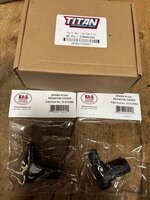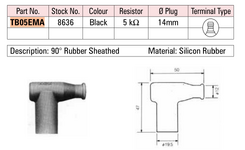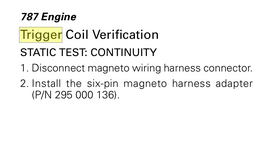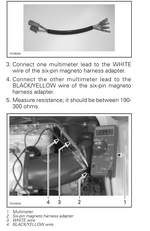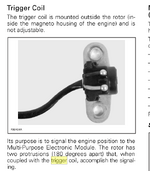-
This site contains eBay affiliate links for which Sea-Doo Forum may be compensated.
You are using an out of date browser. It may not display this or other websites correctly.
You should upgrade or use an alternative browser.
You should upgrade or use an alternative browser.
1997 GTX getting started
- Thread starter JerryLook
- Start date
I was just working on this. My GTX has NGK resistor boots P/N TB05EMA and non resistor (I think) NGK plugs P/N BR8ES. The coil was probably stock. It was a Denso unit
I have never messed with this type of spark plug boot before. So the wire just kind of twists into the end of the boot and that’s how it’s attached? I saw some videos on YouTube about how some boots have the spring inside that you take out, but these boots are not like that.
I have never messed with this type of spark plug boot before. So the wire just kind of twists into the end of the boot and that’s how it’s attached? I saw some videos on YouTube about how some boots have the spring inside that you take out, but these boots are not like that.
The R in BR8ES stands for resistor
To make it simple, was there anything wrong with the old boots?Darn. Is there a recommended non resistor plug I can swap these out with then? Or should I keep the plugs and find some different boots
Quick google search says B8ES
I don’t believe that they are threaded but you do twist them as you take them off and put them on, clip a 1/4” off the plug wire before you put them back on
lagojaguarasp
Member
OEM Spark plug boot part number for you SD is #278000237 wich will show up to be a NGK TB05EM part, a resistor-type boot. Spark plugs are ALSO resistor-type BR8ES NGK. Resistor boot AND resistor spark-plug setups are not that common but that's the factory setup. Would strongly advise against using either a non-resistor plug or boot on any Seadoo. (But if you insist on doing it, please tell us how it went).
I was googling around earlier trying to find a parts catalog for my jetski. To figure out what should be in there. Thank you for that info @lagojaguarasp
lagojaguarasp
Member
Also, while the NGK TB05EM is the OEM part, any boot that has a 5 kΩ resistor should be electrically compatible with the factory style. Regarding the parts catalog, i downloaded many for free from SeaDoo Manuals - FREE PDF Download!. Edit - burtshaver just beat me to it!
Attachments
Great info, see us old timers can learn something too.OEM Spark plug boot part number for you SD is #278000237 wich will show up to be a NGK TB05EM part, a resistor-type boot. Spark plugs are ALSO resistor-type BR8ES NGK. Resistor boot AND resistor spark-plug setups are not that common but that's the factory setup. Would strongly advise against using either a non-resistor plug or boot on any Seadoo. (But if you insist on doing it, please tell us how it went).
Was one of those "always told it was that way" kind of things. Guess next time I have my ski out I will pull the cap and test the resistance.
lagojaguarasp
Member
It controls spark advance and whatnot but it gets the clue on when to fire the spark plugs from the trigger coil (a far simpler and cheaper component that you should be testing)The MPEM box controls spark right?
lagojaguarasp
Member
I checked the trigger coil and it’s good. After I plugged that 6 pin plug back in I tried to fire it up just to see what would happen. Guess what? It fired right up. Maybe the plug just had some corrosion on the pins or a slightly bad connection.
Anyways, now onto replacing the fuel lines. Thank you for all the help! I might need more before I’m done
Anyways, now onto replacing the fuel lines. Thank you for all the help! I might need more before I’m done
lagojaguarasp
Member
That's great news!!I checked the trigger coil and it’s good. After I plugged that 6 pin plug back in I tried to fire it up just to see what would happen. Guess what? It fired right up. Maybe the plug just had some corrosion on the pins or a slightly bad connection.
Anyways, now onto replacing the fuel lines. Thank you for all the help! I might need more before I’m done
lagojaguarasp
Member
I've investigating just that: The ideal fuel line is supposed to be a marine-type, "SAE J1527". There are a few sub-types, A1 to A15. Even from the most Basic A1 sub-type these claim to to have a considerably lesser "permeation" rate compared to, lets say an automotive carb spec "SAE J30R6" wich is good since bilges are usually much less ventilated than car underbodies. Also they claim theese will not collapse under the significant sucction from outboard fuel pumps, wheres the automotive fuel injection type "SAE J30R7" is more tailored for a high (positive) pressure fuel pump.So what is the recommended fuel lines for these? I can probably find a thread about it.
When I replaced the entire fuel system on my SD I had simply asked for a "gas line" hose on the store. Later, I found the so-called "gas hose" was actually a SAR R6 100 spec. A high-pressure hydraulic hose thats not supposed to carry gasoline... I think thats why I could never get rid of a gasoline-like smell (not exatly raw gas) on the bilge. Later i made some changes on my fuel lines and replaced solely the carb and return lines (the largest sections) with clear PVC "gasoline-type" fuel hoses and Boyyy that smell got wayyyyy worse!!!
I had a hard time finding that marine spec hose online and it is considerably more expensive at about 3,30 USD per feet.
But since you are in the States I wouldn't think twice about putting the best possibly hose!
Last edited:
Similar threads
- Replies
- 5
- Views
- 488
- Replies
- 3
- Views
- 449
- Replies
- 42
- Views
- 3,173
- Replies
- 9
- Views
- 921




